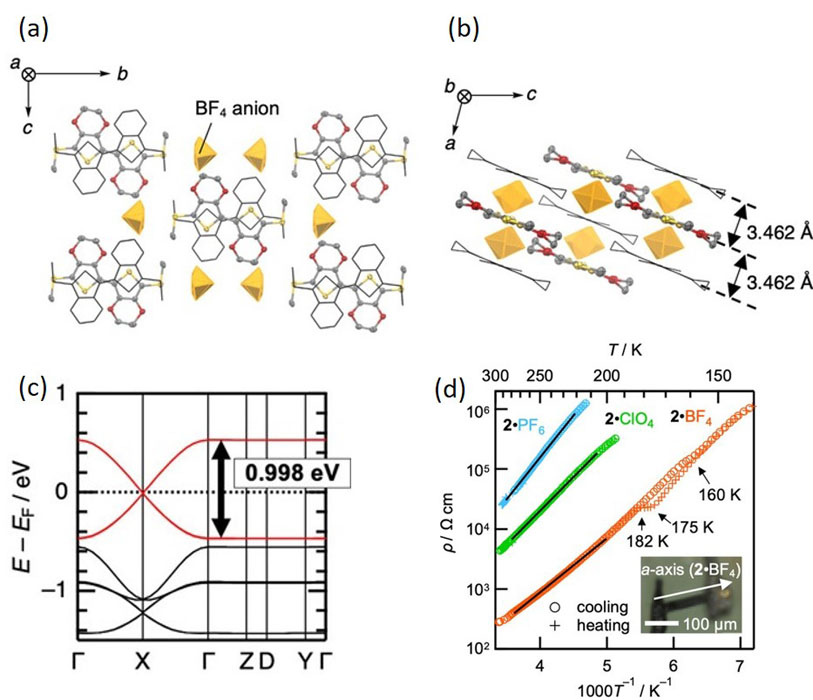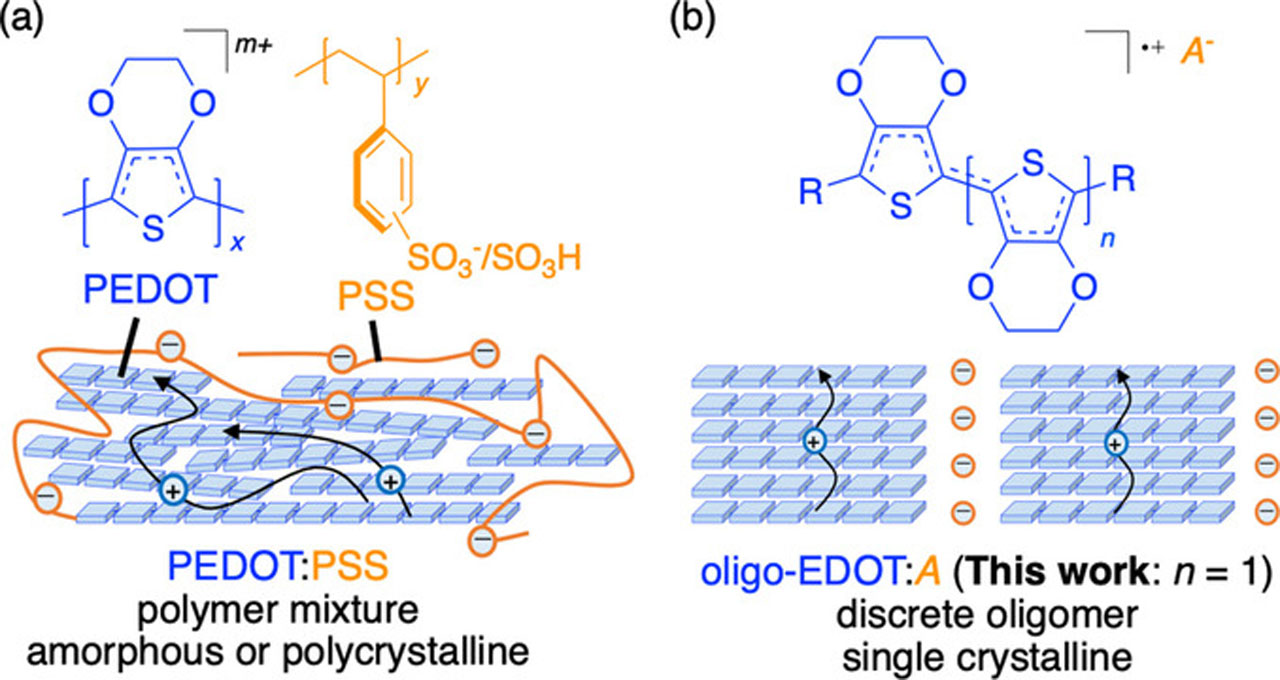Simplest Model for Doped Conducting Polymer: Single-Crystalline Dimer Radical Cation Salts
Mori and Ozaki Groups
Conjugated polymers are essential materials in organic electronic device technologies owing to their mechanical flexibility, lightness, and solution processability. Among them, poly(3,4-ethylenedioxythiophene):poly(styrenesulfonate) (PEDOT:PSS, Fig. 1a), a polyion complex in which the positively charged PEDOT is stabilized by PSS anions, is one of the most widely used conducting polymers. The high conductivity (up to > 4000 S cm−1), transparency, and solution processability have increasingly led them to a wide range of applications, for example, as a hole injection layer in organic photovoltaic (OPV) devices. Nevertheless, in-depth structural information of PEDOT:PSS is sorely lacking, which has severely limited the understanding of the structure-based conducting mechanism requisite for performance improvement; this also hampers molecular design strategies of next-generation electric conductors. One promising approach to elucidate the structure-property relationships of doped PEDOT is to utilize discrete oligo-EDOT∙A models (A: counter anion, Fig. 1b). Recently, we developed oligo-EDOT∙A models with less bulky methylthio (MeS) groups (i.e., 2MeS-2EDOT∙A; A = BF4−, ClO4−, PF6−) that facilitate the growth of X-ray quality single crystals with adequately tight π-stacking. Combination of the atomic-level structural analyses and physical property measurements of the discrete oligomer systems revealed strong π–π interactions along the stacking direction as the origin of the excellent conductivity of doped PEDOT.
Single crystals of charge-transfer salts 2MeS-2EDOT∙A were then synthesized by the electrochemical oxidation of 2MeS-2EDOT in the presence of n-Bu4N∙A electrolyte. The X-ray structural analyses at 293 K revealed a 1:1 composition of oxidized 2MeS-2EDOT (i.e., monovalent radical cation 2MeS-2EDOT+) and counter anion A located in the voids of 2MeS-2EDOT+ donors (Figs. 2a, b). In each structure of 2MeS-2EDOT∙A, the donors were tightly stacked in a one-dimensional (1D) configuration with a head-to-tail pattern and with the donors rotated 1–3° at the centroid along the π-stacking axis. Interestingly, the donors were uniformly π-stacked in the range 3.46–3.48 Å, consistent with those predicted for PEDOT:PSS (3.43–3.51 Å).

Fig. 2 Structures of 2MeS-2EDOT∙BF4 along (a) the a-axis and (b) the b-axis. The orange polyhedra represent the disordered BF4 anions. (c) Calculated band structure of 2MeS-2EDOT∙BF4 and (d) ρ (resistivity) – Temperture−1 plots of 2MeS-2EDOT∙A (A = BF4, ClO4, PF6) Inset: a picture for the single crystal of 2MeS-2EDOT∙BF4 used in the measurement. Solid lines show fittings of the Arrhenius law.
We investigated the band structures based on the crystal structures using first-principles density functional theory (DFT) calculations (OpenMX software). Concerning the 1+ electronic charge of the molecule and its crystallographycally uniform π-stacking structure, the HOCO band exhibited a half-filled state with no energy gaps at the Fermi level (Fig. 2c), suggesting a metallic electronic state. The band width W of the HOCO band was determined to be as high as 0.998 eV (Fig. 2c). This result indicates the exclusively strong molecular interaction (W ≈ 1 eV) found in 2MeS-2EDOT∙A. The geometric and electronic structures of π-stacking are the most critical factors for the high conductivity of doped PEDOT.
We then measured the electrical resistivity (ρ) of 2MeS-2EDOT∙A. The ρ along the long axis direction of the crystal shape (the donor stacking a-axis) of 2MeS-2EDOT∙BF4 was determined as 2.8 × 102 Ω cm (Fig. 2d) at room temperature. From an Arrhenius plot, the activation energy was determined as 177.2 ± 0.9 meV, exhibiting almost no T-dependence. Considering the metallic half-filled electronic state indicated by the band calculations (Fig. 2c), the semiconducting behavior suggests that 2MeS-2EDOT∙BF4 is in a “genuine (half-filled) Mott state” with localized and poorly conducting electrons because of on-site Coulomb repulsion (U). The semiconducting behavior despite large W indicates that U is dominant over W in this system. Such a genuine Mott state (expressed as U > W) with large W is quite rare in organic conductor series. The semiconducting behaviors were likewise observed in 2MeS-2EDOT∙ClO4 and 2MeS-2EDOT∙PF6, and the room temperature ρ was determined as 4.3 × 103 Ω cm for 2MeS-2EDOT∙ClO4 and 4.3 × 104 Ω cm for 2MeS-2EDOT∙PF6, respectively. The increase of ρ by one order of magnitude each was observed as the anion size increased and the π-stacking distances elongated (BF4−<ClO4−<PF6−, Fig. 2d). Activation energies were also determined as 223.6 ± 0.5 meV for 2MeS-2EDOT∙ClO4 and 277.9 ± 1.4 meV for 2MeS-2EDOT∙PF6, reflecting the chemical pressure effect from the anion sizes. It is to be noted that in the ρ–T−1 plot for 2MeS-2EDOT∙BF4, we observed a slight transition at 160 and 175 K for the cooling and heating processes, respectively , with a hysteresis of T (Fig. 2d), suggesting that a first-order phase transition is involved.
In conclusion, we developed tightly π-stacked models for discrete EDOT dimers 2MeS-2EDOT∙A. These models exhibited unique 1D half-filled electronic structures with exclusively large band width (W ≈ 1 eV) along the intracolumnar direction, implying the origin of the high electrical conductivity of doped PEDOT. The room temperature conductivities (σ = ρ−1; < 3.6 μS cm−1) were lower than that of doped PEDOT (> 4000 S cm−1), which may originate in the genuine Mott state of our models caused by large U relative to W. The control of the competition between U and W in these systems (e.g., by elongating conjugation lengths to reduce U) may realize a variety of electronic states, including the metallic and even superconducting states. This unique approach of controlling U is accessible exclusively using our oligomer strategy. The construction of an oligomer library will further elucidate relationships between the structures and electronic properties.
References
- [1] R. Kameyama, T. Fujino, S. Dekura, M. Kawamura, T. Ozaki, and H. Mori, A European Journal, 27, 6696 (2021).
- [2] R. Kameyama, T. Fujino, S. Dekura, and H. Mori, Phys. Chem. Chem. Phys. 24, 9130 (2022).
- [3] R. Kameyama, T. Fujino, S. Dekura, S. Imajo, T. Miyamoto, H. Okamoto, and H. Mori, J. Mater. Chem. C. 10, 7543 (2022).

